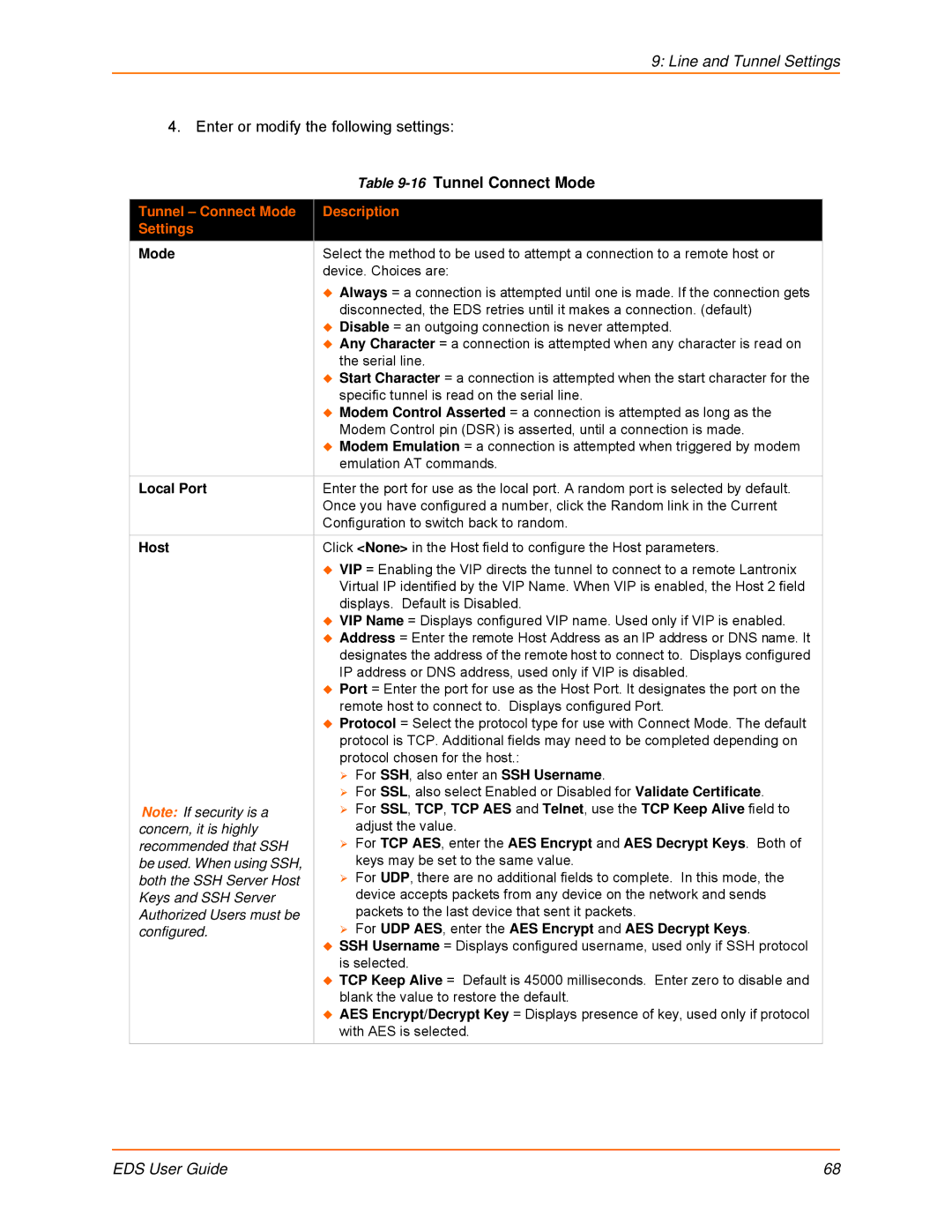
9: Line and Tunnel Settings
4. Enter or modify the following settings:
| Table |
|
|
Tunnel – Connect Mode | Description |
Settings |
|
Mode | Select the method to be used to attempt a connection to a remote host or |
| device. Choices are: |
| Always = a connection is attempted until one is made. If the connection gets |
| disconnected, the EDS retries until it makes a connection. (default) |
| Disable = an outgoing connection is never attempted. |
| Any Character = a connection is attempted when any character is read on |
| the serial line. |
| Start Character = a connection is attempted when the start character for the |
| specific tunnel is read on the serial line. |
| Modem Control Asserted = a connection is attempted as long as the |
| Modem Control pin (DSR) is asserted, until a connection is made. |
| Modem Emulation = a connection is attempted when triggered by modem |
| emulation AT commands. |
|
|
Local Port | Enter the port for use as the local port. A random port is selected by default. |
| Once you have configured a number, click the Random link in the Current |
| Configuration to switch back to random. |
Host | Click <None> in the Host field to configure the Host parameters. |
| VIP = Enabling the VIP directs the tunnel to connect to a remote Lantronix |
| Virtual IP identified by the VIP Name. When VIP is enabled, the Host 2 field |
| displays. Default is Disabled. |
| VIP Name = Displays configured VIP name. Used only if VIP is enabled. |
| Address = Enter the remote Host Address as an IP address or DNS name. It |
| designates the address of the remote host to connect to. Displays configured |
| IP address or DNS address, used only if VIP is disabled. |
| Port = Enter the port for use as the Host Port. It designates the port on the |
| remote host to connect to. Displays configured Port. |
| Protocol = Select the protocol type for use with Connect Mode. The default |
| protocol is TCP. Additional fields may need to be completed depending on |
| protocol chosen for the host.: |
| For SSH, also enter an SSH Username. |
| For SSL, also select Enabled or Disabled for Validate Certificate. |
Note: If security is a | For SSL, TCP, TCP AES and Telnet, use the TCP Keep Alive field to |
concern, it is highly | adjust the value. |
recommended that SSH | For TCP AES, enter the AES Encrypt and AES Decrypt Keys. Both of |
be used. When using SSH, | keys may be set to the same value. |
both the SSH Server Host | For UDP, there are no additional fields to complete. In this mode, the |
Keys and SSH Server | device accepts packets from any device on the network and sends |
Authorized Users must be | packets to the last device that sent it packets. |
configured. | For UDP AES, enter the AES Encrypt and AES Decrypt Keys. |
| SSH Username = Displays configured username, used only if SSH protocol |
| is selected. |
| TCP Keep Alive = Default is 45000 milliseconds. Enter zero to disable and |
| blank the value to restore the default. |
| AES Encrypt/Decrypt Key = Displays presence of key, used only if protocol |
| with AES is selected. |
EDS User Guide | 68 |
